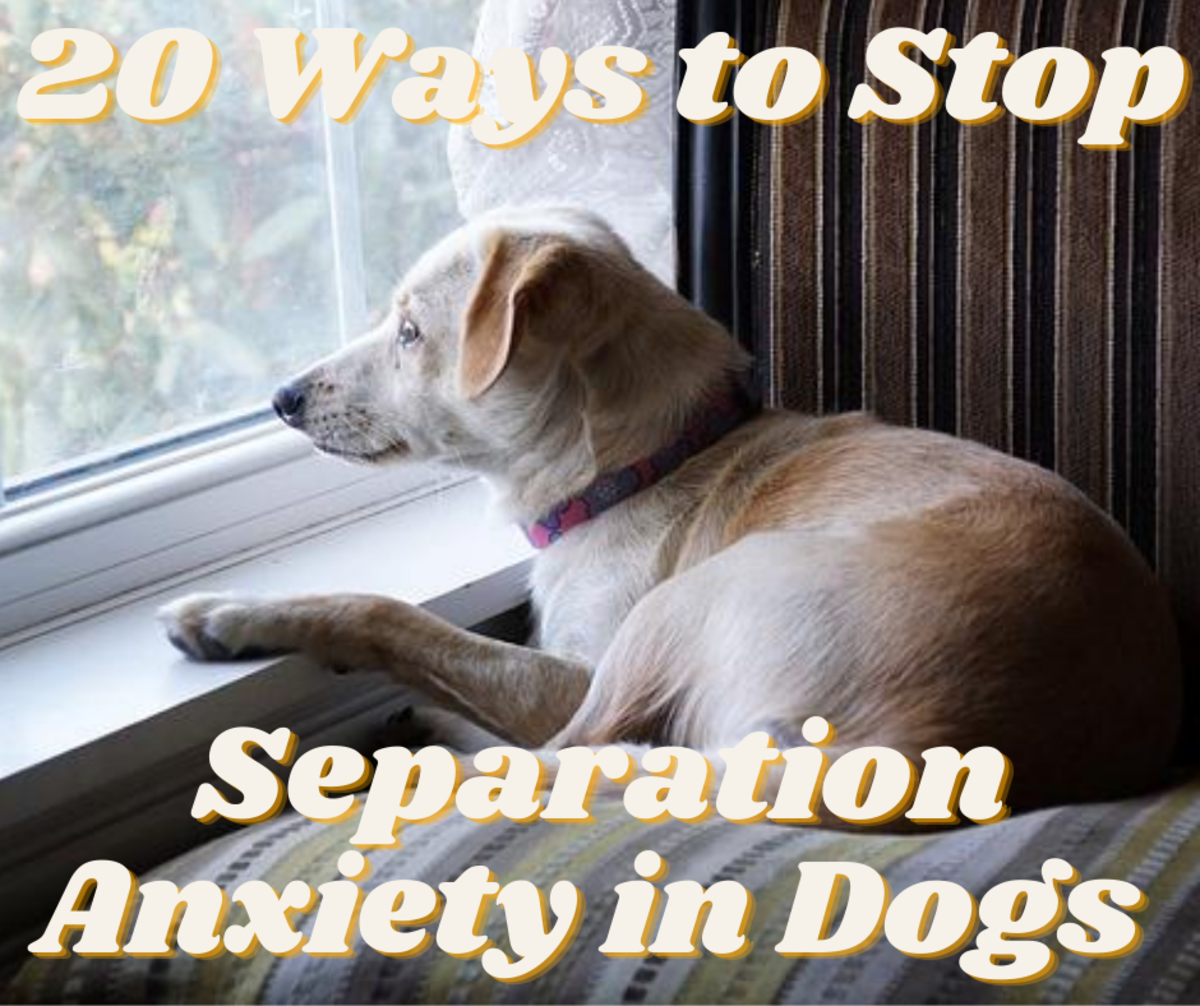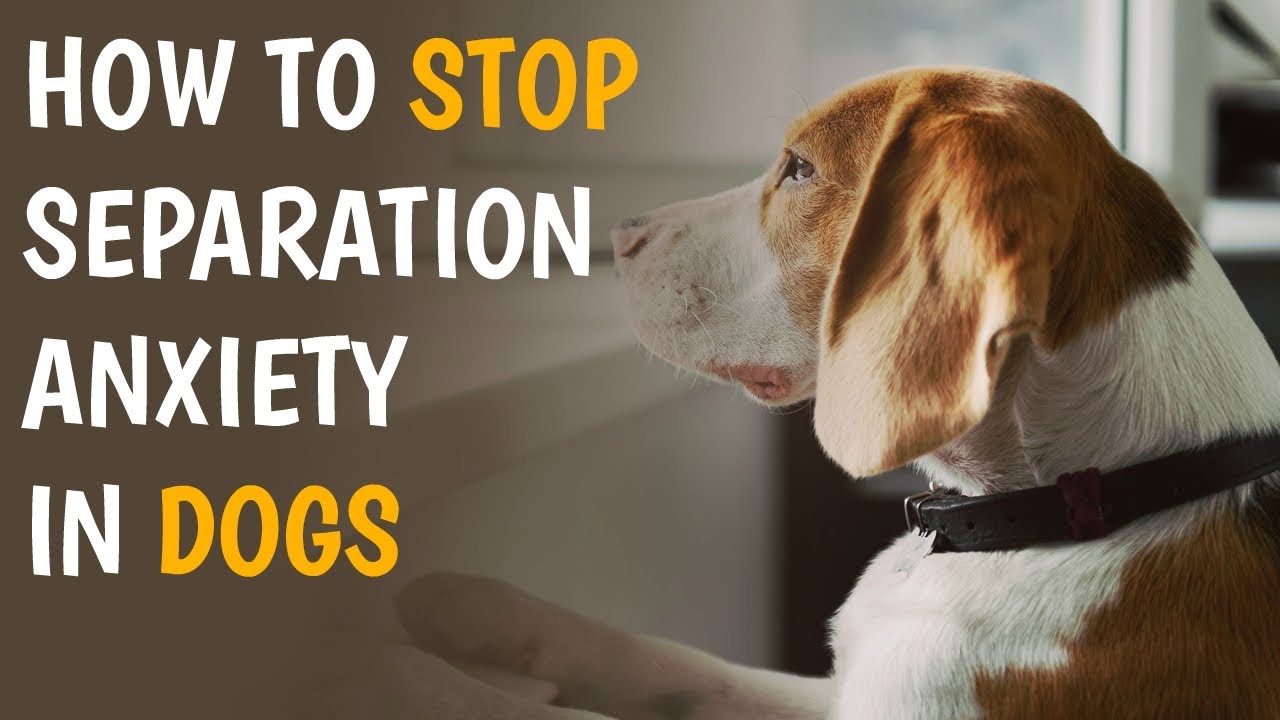Other Problems That Can Cause Barking
Illness or InjuryDogs sometimes bark in response to pain or a painful condition. Before attempting to resolve your dogs barking problem, please have your dog examined by a veterinarian to rule out medical causes.
Excessive barking due to separation anxiety occurs only when a dogs caretaker is gone or when the dog is left alone. Youll usually see at least one other separation anxiety symptom as well, like pacing, destruction, elimination, depression or other signs of distress. For more information about this problem, please see our article, .
What Causes Dog Separation Anxiety
Dogs can develop separation anxiety for a number of reasons, and many of them are related to changes in the dogs life. These include:
-
Family changes: For example, when a member of the dogs family moves out of the home
-
Home changes: For example, when a dog is rehomed, or moves with their family to a new house
-
Routine changes: For example, when a pet parent starts a new job with longer hours
Some dogs respond to changes like these with relatively little anxiety for others, separation anxiety rears its stressed-out head. No one knows for sure why some dogs are more susceptible to separation anxiety than others. Even dogs whove been raised in supportive homes with plenty of attention and positive reinforcement can be affectedso dont blame yourself!
Some experts believe that a dogs genetics could play a role. Certain dog breeds appear to be more prone to separation anxiety than others, including:
But your dogs breed isnt the only factor it’s also not unusual for an individual dog from a “low risk” breed to develop separation anxiety.
Establish & Isolate An Area
Consider installing a stair gate or child gate.
The idea behind this is to determine an area where your dog feel comfortable to keep them when left alone.
Make it as comfortable as possible with toys, bedding and water and leave them in there while you are elsewhere in the house, ideally after a good walk or exercise session.
Confused as they may be to start with, they will know that they are not alone in the house and will settle down to their own devices.
In an ideal scenario, this should be employed overnight as well so they become even more familiar with being alone for long periods.
Try to avoid shutting them inside one place though.
Gates are great because while they provide some restriction they allow noise and scents to continue to waft around the house and prevent claustrophobia.
Consider also leaving on the radio talk stations are better than music so that they become familiar to consistent background noise.
Further down the line, the objective will be to have a dog who will understand and obey the command Bed and not feel remotely stressed at the prospect.
Recommended Reading: How To Get Rid Of Anxiety Stomach Pain
Take Your Dog For Walks
Taking your dog for walks is a great way to help them ease their separation anxiety symptoms, as well as maintain a healthy weight and lower their blood pressure. Walking is not only good for your dogs health, but it can be a great way to bond with your pet as well. People are not the only ones who benefit from a regular exercise routine. Like humans, pets with an excess of energy can also become more anxious, so keeping your dogs energy levels managed with regular exercise is an important measure to take.
My Dog Starts To Get Anxious Even Before I Leave What Can I Do

There are a number of activities that we do consistently prior to each departure. The dog soon learns to identify that these cues or signals mean imminent departure. On the other hand, some dogs learn that other signals indicate that you are not planning to depart and therefore can help the dog to relax. If you can prevent your dog from observing any of these anxiety inducing pre-departure cues, or if you can train your dog that these cues are no longer predictive of departure, then the anxiety is greatly reduced. Even with the best of efforts, some dogs will still pick up on “cues” that the owner is about to depart. Train your dog to associate these cues with enjoyable, relaxing situations rather than the anxiety of impending departure. By exposing your dog to these cues while you remain at home and your dog is relaxed or otherwise occupied, they should no longer predict departure. This entails some retraining while you are home. Get the items that normally signal your departure, and walk to the door. However, do not exit the house. The dog will be watching and possibly get up, but once you put everything away, your dog should lie down. Then, once your dog is calm, this is repeated. Only 3 to 4 repetitions should be done in a day and the dog must be calm and quiet before presenting the cues again. Eventually, your dog will not attend to these cues because they are no longer predictive of you leaving. Then, your dog will be less anxious when you do leave.
You May Like: How To Get Rid Of Anxiety Naturally
Symptoms Of Separation Anxiety
- Scratching and digging near doors and windows
- Trying to escape
- Destructive behavior such as chewing door frames or other items
- Barking, whining or howling
- Excessive salivation
- Chewing on or licking themselves
In extreme cases, your dog may even urinate or defecate because of the physiological effect of prolonged stress.
RELATED: Why conventional anxiety medications arent the best choice
What Is Separation Anxiety In Dogs
Dogs with separation anxiety often turn to destructive behaviors loud or excess vocalization and house soiling despite being potty trained.
Separation anxiety in dogs is a common issue. Namely, separation anxiety affects as much as one in every four to six dogs. In other words, the behavioral issue is diagnosed in 20-40% of dogs presented to canine behaviorists.
You May Like: What Is Stress And Anxiety
Cameras: Dont Have Mom Guilt
Leaving your loved one behind can be as stressful on pet parents as it is for your pup. But theres no need to suffer from unnecessary guilt. Your furry family member will be excited to see you when you return, no matter the circumstances.
If you need a regular Fido fix while out, a dog camera is an effective way to peek in on your pup. Most pet cams will record and have motion detection. Some even have two-way audio so you can talk to them. However, we dont recommend talking to them too often as it can be confusing, and they may think youre at home when youre not. You can also find smart feeders that can feed your dog treats with a command from your smartphone.
Seeking The Help Of A Professional
If our treatment advice hasn’t eased the separation-related behaviour, talk to a vet who knows you and your dog. They should then refer you to a clinical animal behaviourist. They’ll help you identify the underlying cause of the problem and develop a treatment plan that works for your dog as well as you.
Also Check: Can Anxiety Last All Day
What Causes Separation Anxiety In Puppies And Dogs
Its unclear why some puppies are more prone to separation anxiety than others. McConnell theorizes there may be several reasons, including never previously being left alone and traumatic separation, such as would be seen in some abandoned shelter dogs. Even a single traumatic event in the owners absence, like the house being robbed, can lead to SA. Finally, she suggests that personality can play a role, with clingy dogs perhaps being more at risk than independent ones.
Other triggers to watch for involve life changes like a sudden switch in schedule, a move to a new house, or the sudden absence of a family member, whether its a divorce, a death in the family, or a child leaving for college. Recent research has even pointed to a lack of daily exercise as a possible cause. Because there are so many potential triggers for SA, its essential to work on prevention and start treatment at the first sign.
How Long Does It Take
Its all dependant on how committed you are to take it slow, how traumatised your dog is and where you incorporate the Five To Thrive.
Always have a camera up so you can gauge progress. However, youll know by the behaviour of your dog whether youre trying to fast track. Hyper behavior on return is an indication youve may have been out too long.
You May Like: Can Anxiety Cause Chest Pain Everyday
How Do You Know If Your Dog Is Happy Alone
Pop a filming device up in the room you leave your dog alone at home. It will give you the answer.
Helping your dog relax at home
Place your dog in a room at the back of the house. Its quiet and there are no worries about a knock at the door or letters being delivered. For many dogs, these activities are a great concern.
No opportunity to sit and bark out of the window at passers-by means there is no guard job to do for dogs. Out of sight is out of mind.
Signs Your Dog Suffers From Separation Anxiety

- A dog who gets agitated with signs that you are about to depart
- Continuous/intermittent but regular barking and howling when no other triggers are recorded
- Urinating and defecating when left alone or separated from their human
- Pacing
- Escaping from their confinement when youre not about
- Destructive of household items, scratching / chewing walls, and doors when youre out
- Panting and salivating. On your return, you may notice your dog is wet from excessively salivating and panting profusely.
- Less obvious is laying quietly panting and yawning
- Ask your neighbours if they hear anything
- Pop a camera up so you can watch and listen on your return as to how your dog coped alone. Have you noticed any of the above?
Read Also: What Can Help My Anxiety
Why Do Some Dogs Develop Separation Anxiety
There is no conclusive evidence showing exactly why dogs develop separation anxiety. However, because far more dogs who have been adopted from shelters have this behavior problem than those kept by a single family since puppyhood, it is believed that loss of an important person or group of people in a dogs life can lead to separation anxiety. Other less dramatic changes can also trigger the disorder. The following is a list of situations that have been associated with development of separation anxiety.
Change of Guardian or FamilyBeing abandoned, surrendered to a shelter or given to a new guardian or family can trigger the development of separation anxiety.
Change in ScheduleAn abrupt change in schedule in terms of when or how long a dog is left alone can trigger the development of separation anxiety. For example, if a dogs guardian works from home and spends all day with his dog but then gets a new job that requires him to leave his dog alone for six or more hours at a time, the dog might develop separation anxiety because of that change.
Change in ResidenceMoving to a new residence can trigger the development of separation anxiety.
Change in Household MembershipThe sudden absence of a resident family member, either due to death or moving away, can trigger the development of separation anxiety.
Recovery And Management Of Separation Anxiety In Dogs
Managing separation anxiety requires patience. Your veterinarian will help you come up with a treatment plan and training regimen, but there are some things you can do in the meantime to alleviate some of your dogs stress. Frequent exercise, for example, can help tire your dog out and stimulate her physically and mentally prior to time spent alone. Training, exercise, and play sessions not only eliminate boredom, but they also help you build stronger bonds with your dog, and can help build your dogs confidence. Slow feeding bowls or toys can also provide your dog with a tasty distraction while you are gone. This can be especially helpful if you are only leaving the house for short periods, as it can reinforce positive experiences with solitude.
Many owners accidentally reinforce negative behaviors. Staying calm when leaving the house will help your dog remain calm, and it is equally important to remain calm when you return. While it may be hard to ignore your dogs exuberant greeting, feeding into it can heighten your dogs anxiety around arrivals and departures.
Some high-energy dogs may require more stimulation than others. Doggy daycares can help tire these dogs out while also reducing the stress that separation anxiety places on owners. Getting involved in dog sports or activities can also stimulate these dogs and reduce boredom-induced destructive behaviors.
Read Also: How To Know If You Have An Anxiety Disorder
How Long Can My Dog Be Left Alone
As a general rule, your dog should never be left alone for more than four hours at a time. However, this will greatly depend on your dog, their age, breed and how they cope with being on their own in the house. Some may struggle being away from their owners for this long and others will be unphased.
Dealing With Dog Separation Anxiety
One of the most common phrases used by owners to describe a dog that appears stressed when the owner leaves homeor just leaves the roomis separation anxiety in dogs.
We can define separation anxiety as a dog problem behavior that shows itself through symptoms like excessive salivation, barking, whining, destroying items in the home, scratching at walls, doors and floors, and attempting to escape from the crate, or room.
Read Also: What Is An Anxiety Attack Like
Provide Interactive Toys For Your Dog To Play With While Youre Gone
Dogs with mild separation intolerance can also learn to enjoy the ritual of getting a treat-stuffed goody when their person leaves the house for the day. However, Flores cautions against leaving interactive food toys with dogs that are suffering from full-blown separation anxiety.
Sometimes, because the food toy has been given so often before departure, the food becomes a cue that something bad is about to happen, she explains. Once the food has been consumed, the dog will realize their person is still gone and panic.
How Do You Help A Dog With Separation Anxiety
It can be mentally and physically stressful for a dog when their owner leaves them home alone.
Dogs who have separation anxiety may act out because of their instinct, not necessarily out of bad behavior.
Punishing a dog for acting out will not do any good.
Training Tip: If your dog has separation anxiety, most of the destruction will occur in the first 30 minutes of your departure.
Also Check: How To Calm Flying Anxiety
How To Treat Separation Anxiety In Dogs
Its crucial to know how to treat separation anxiety in dogs for peace of mind for both the dog and the owner. Knowing that your dog is home alone, suffering from stress and anxiety, can impact your daily life and hinder your work and social life.
Prolonged separation anxiety can lead to health issues and illness in your dog, which is why its so imperative to know how to treat it. In this section, well be discussing the various methods of how you can go about treating separation anxiety in dogs.
Treatment is not a one size fits all scenario. There are many different treatment options and methods available and the right solution for your dog is dependent on his or her needs. It might take some trial and error before you figure out a method that works, so its important to stay committed to finding a solution.
These are the most common treatment options for dogs suffering from separation anxiety:
- Desensitization: The goal of desensitization is to gradually make your dog less sensitive to being alone. Start by leaving them alone for short periods of time that wont trigger anxiety, then move up to longer periods of time.
Anti-anxiety medication for dogs has proven to be very helpful in these scenarios. If youre contemplating if medication is the right solution for your dogs separation anxiety, let us help. Our team of Dutch-affiliated veterinarians can help you determine whether your dogs symptoms of separation anxiety can be resolved through medication.
Video Answer: How To Stop Your Dog’s Separation Anxiety

Doggy daycare could be a good way to provide your dog some relief from boredom and .
Photo naughty playful puppy dog after biting pillow tired of hard work.
However, not all dogs are cut out for a group environment.
And while that second dog may help alleviate the first dog’s symptoms, his presence doesn’t fix the underlying separation-related anxiety.
If you really DO want a second dog, the first course of action is to help your existing dog overcome the separation-related anxiety before bringing in the new addition.
And while that second dog may help alleviate the first dog’s symptoms, his presence doesn’t fix the underlying separation-related anxiety.
If you really DO want a second dog, the first course of action is to help your existing dog overcome the separation-related anxiety before bringing in the new addition.
Punishment. Punishment isn’t effective for treating and can make the situation worse. Another dog. Getting your dog a companion usually doesn’t help an anxious dog because their anxiety is the result of their separation from you, not just the result of being alone.
And while that second dog may help alleviate the first dog’s symptoms, his presence doesn’t fix the underlying separation-related anxiety.
You May Like: What’s The Difference Between Stress And Anxiety